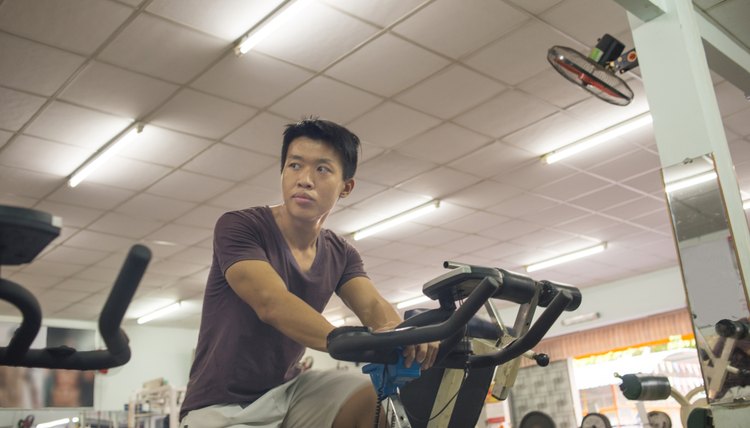What does fact checked mean?
At SportsRec, we strive to deliver objective content that is accurate and up-to-date. Our team periodically reviews articles in order to ensure content quality. The sources cited below consist of evidence from peer-reviewed journals, prominent medical organizations, academic associations, and government data.
The information contained on this site is for informational purposes only, and should not be used as a substitute for the advice of a professional health care provider. Please check with the appropriate physician regarding health questions and concerns. Although we strive to deliver accurate and up-to-date information, no guarantee to that effect is made.
Are Stationary Bikes Good for Knee Rehab?

Your knee isn’t just the largest joint in your body -- it’s also quite complex, according to the American Academy of Orthopaedic Surgeons. As a result, it’s very susceptible to injury, many of which can be treated non-surgically. Rehabilitation from a knee injury may include the standard RICE approach -- rest, ice, compression and elevation. Exercise, including cycling on a stationary bike, can also potentially provide relief and prevent further injury. Consult your doctor, however, before beginning this or any exercise regimen.
Rehabilitation Purpose
When you suffer a knee injury the muscles, tendons and ligaments become weak and the joint gets unstable. Rehabilitative exercises strengthen the muscles and joint structures that support the knee, improve stability and increases flexibility and range of motion, according to the National Institute of Arthritis and Musculoskeletal and Skin Diseases.
Quad Builder
According to Robert Klapper and Lynda Huey, authors of “Heal Your Knees,” a bicycle program nurtures weight-bearing joints such as the knees. Also, because a cycling motion involves only the hinge joint part of the knee’s function, it doesn’t put any potentially damaging rotational torque on your knees, they explain. Also, biking on a stationary or regular bike builds up the quadriceps muscles, the primary protectors of your knees.
Different Bike, Different Ride
As Klapper and Huey point out, athletes or former athletes are more likely to favor upright bikes. But, if you’re older or have a back problem, a recumbent or reclining bike may be more suitable for you to use during your knee rehab. They recommend trying out both types of bikes to determine which feels better and which you find more effective for your knee.
Use Good Form
Setting the seat height is the most critical consideration when using a stationary bike to rehabilitate your knee. Your seat should be set at a height that allows you to keep your knee almost straight at the bottom pedal position. If your knee straightens fully or bends more than a few degrees, adjust your seat. Klapper and Huey also recommend that the seat be flat rather than tilting upward or downward and that you keep your knees and feet pointing straight ahead.
Duration and Intensity
The AAOS recommends cycling for 10 minutes a day at light resistance at the beginning of your rehabilitation. Add an extra minute each day until you’re cycling 20 minutes daily. As your knee becomes stronger, gradually increase the resistance as well.
When to Stop
If at any time your pain or any other symptoms become worse, stop cycling and notify your doctor or physiotherapist. According to Brian Halpern, a sports medicine physician and author of “The Knee Crisis Handbook," a recumbent bike may take some of the pressure off your knees during cycling. Or, he recommends using a bicycler ergometer, which allows you to use your arms to turn the pedals of a stationary bike.
References
- American Academy of Orthopaedic Surgeons: Common Knee Injuries
- National Institute of Arthritis and Musculoskeletal and Skin Diseases: Knee Problems
- Heal Your Knees; Robert Klapper, M.D. and Lynda Huey
- American Academy of Orthopaedic Surgeons: Knee Arthroscopy Exercise Guide
- The Knee Crisis Handbook; Brian Halpern, M.D. and Laura Tucker
Writer Bio
Kay Uzoma has been writing professionally since 1999. Her work has appeared in "Reader’s Digest," "Balance," pharmaceutical and natural health newsletters and on websites such as QualityHealth.com. She is a former editor for a national Canadian magazine and holds a Bachelor of Arts in political science from York University.
